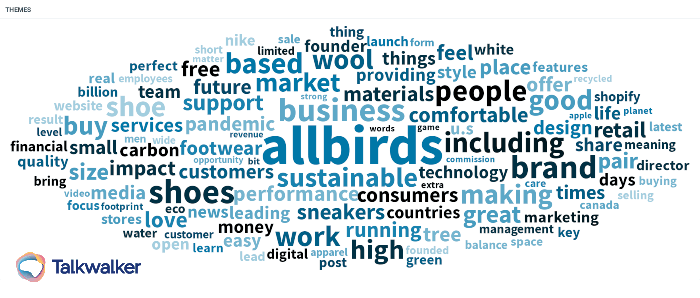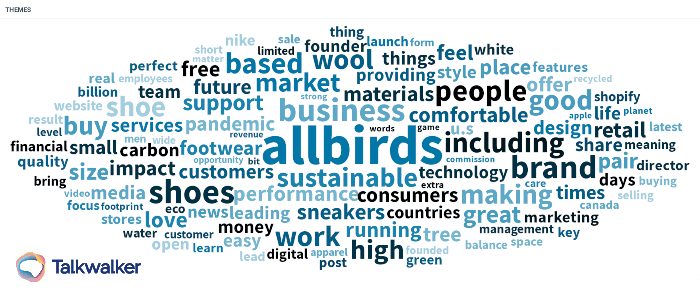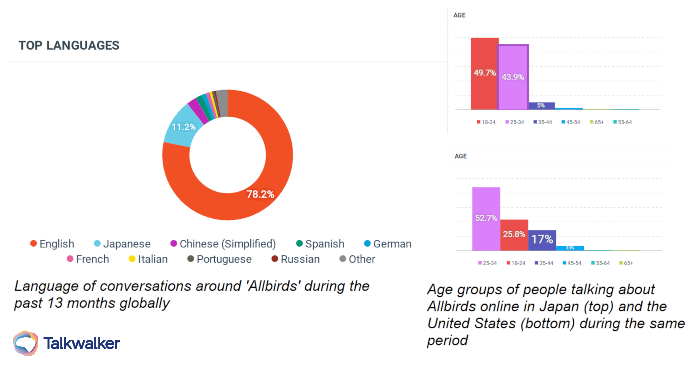What brand image really is Talkwalker
Brand image remains an elusive concept that is usually confused with brand identity
June 9, 2021

Analyze your brand image with real-time data
If the first word that comes to mind is ‘sustainability’ then you already know what brand image is, even if you are not aware of it. All these brands promote the idea of going back to nature and to consuming responsibly, rather than buying things you don’t need. This commitment to sustainability has established trust and transparency between the brand and consumers. These subliminal associations are based on a series of brand identity elements that collectively result in a positive first impression.
However, depending on who you ask, brand image remains an elusive concept that is usually confused with brand identity. The clothing and outdoor equipment brands embraced the idea that consumers nowadays are more willing to pay a small premium for products that are less harmful to the environment. Looking at each of their websites, one could tell that they’re not directly selling you the product, but instead they’re making you feel like you’re part of something bigger and that your lifestyle is part of the movement that’s changing the world.
For example, if we consider the top themes surrounding Allbirds during the past 13 months globally, we realize that the recurring themes are not related to commerce-related terms such as ‘expensive’ or ‘sale’. With that being said, one could tell that people who are talking about Allbirds online are appreciating the fact that the running shoes are sustainable, comfortable, and have a small carbon footprint.

Top themes surrounding trendy shoe company Allbirds during the past 13 months globally.
Simply put, your brand identity is defined by what you’re saying (this could be your logo, tagline, aesthetics, tone of voice, etc.). On the other hand, brand image is how people perceive those messages and therefore create an image and a feeling in their head.
What are people saying about your brand?
What is brand image?
Brand image is how people perceive and associate with your brand, based on the story you tell over an extended period. It is the end result of all your marketing, communications, and branding efforts that could not be measured or tracked, especially as it only exists in your customers’ heads and hearts. Your brand image is your reputation, whether that’s good or bad.
Reputation managers would tell you that monitoring the constant fluctuation of brand image is an almost impossible task to do manually. Therefore, utilizing a conversational intelligence platform is an indispensable tool in the process of shaping the emotions affiliated with a brand. Keeping an eye out on what people are saying about your brand, would give you insight into how they’re really feeling and how to address any issues.
Brand image is constantly evolving and requires a substantial budget to maintain, grow, and protect. With consumer behavior and brand sentiment shifting, brand managers have to think of new ways to adapt their messaging and story so they remain relevant and likable. It is a particularly unique challenge for companies with a global presence, as they attempt to portray a consistent image to an international audience, who is increasingly expecting a hyper-personalized digital experience. Indeed, creating a solid brand image is partly shaped by your long-term content strategy.
If we consider the language of online conversations surrounding Allbirds during the past 13 months, we realize that 78.2% of those are happening in English and 11.2% are in Japanese.

Language of conversations surrounding Allbirds during the past 13 months, while cross-examining it with the age groups per country.
In Japan, the majority of online conversation is coming from users in the age group of 18-24, whereas in the United States the majority of conversations are coming from ages 25-34. However, what’s interesting is if we compare the tagline of the American Allbirds website with the Japanese one:
American website tagline: Light on your feet. Light on the planet.
Japanese website tagline: Have fun every day. Be kind to the earth. Let’s color your summer!
By comparison, it is clear that Allbirds copywriting team decided to embrace a younger and more hip personality for the Japanese site and a more serious tone for the US one.
Another way to leverage conversational data is to measure brand health. Performing sentiment analysis over an extended period helps brand managers unravel moments where there’s negative sentiment. Using Talkwalker’s Quick Search tool, we can study the overall online sentiment around Allbirds.

Brand sentiment analysis of Allbirds during the past 13 months globally shows that it has all been positive.
Explore the sentiment surrounding your brand
Brand image upkeep is a meticulous task that requires you to be there for your community and to continuously provide value for your stakeholders, not only your clients. Creating an inspirational brand image requires that you first know who your brand is and what it stands for. Having this basic understanding of who you are will help create a narrative that not only sticks in your target customers’ minds but also wins their hearts.
How to create a strong brand image
Before you start working on your brand image, you need to first know who you are, who you want to be, and who you want to talk to.
Take the time to clearly define your mission, vision, and company values. These key principles will guide your entire communications and messaging. Think of what added value you’re bringing to your customers and how your purpose fits in the grand scheme of things.
Establish a consistent and unique brand positioning statement that lays out what your brand does, its benefits, and your target customer. This statement is generally an internal document that helps align all marketing and communications efforts.
Develop a brand personality that matches your goals and audience’s preferences. Embracing a brand voice that is likable and approachable is necessary for today’s emotionally-driven consumer culture. However, a brand’s personality is not something that’s set in stone -- it must adapt and continuously evolve within the space created by your mission statement.
Know who you’re talking to. Profiling your community into personas gives you the ability to tailor your messaging and create impactful stories that reflect your friendly side.
Take the first step towards having a strong brand image
One brand that has been particularly successful at creating a strong brand image is LEGO, one of the world’s most loved brands according to Talkwalker’s Love Brands 2020 report. What LEGO managed to do is expand their lineup of products and services, all while maintaining a nostalgia-fueled relationship with their customer base across all ages.
How do you measure the success of your brand image?
Brand image is tricky to measure, especially as each consumer has a unique and particular experience with a brand, and therefore forms their image in their head. However, the following guidelines should allow you to better understand the process.
Survey your audiences: It doesn’t matter whether you ask them through social media, surveys, polls, direct phone calls, chatbots, or in focus groups, asking your audience for honest reviews and feedback is crucial to measuring brand image. You can do a brand recall test where your audience is given a brand and should list as many associations as possible (these could be as simple as emojis or as complicated as psychological reactions). Another way to survey your brand image is by doing a brand impact test that helps market researchers assess brand position (answering questions like ‘Do you recognize this logo?’, ‘How does this tagline make you feel?’, ‘Between these two brands, which one would you feel more comfortable telling your secret to?’, etc.)
Analyze the data and react: Real-time conversational data is a goldmine for any brand manager looking to engage audiences.
Monitor how your brand image evolves: Perform a granular sentiment analysis of your brand and see what conversations are surrounding your brand. This will help you explore unforeseen partnership opportunities with relevant brands, and even maximize your marketing budget ROI.
Repeat.
One thing to keep in mind is that these guidelines might not give you an accurate picture of your brand image, though they do provide general indicators of the status of your brand’s health.
Don’t wait until your brand image is tarnished, protect it
To sum things up, brand image is a long-term endeavor that lies at the heart of all your business operations. Think of how your business will grow if customers correlated your brand with all positive connotations and were constantly eager to hear (and share your news).

